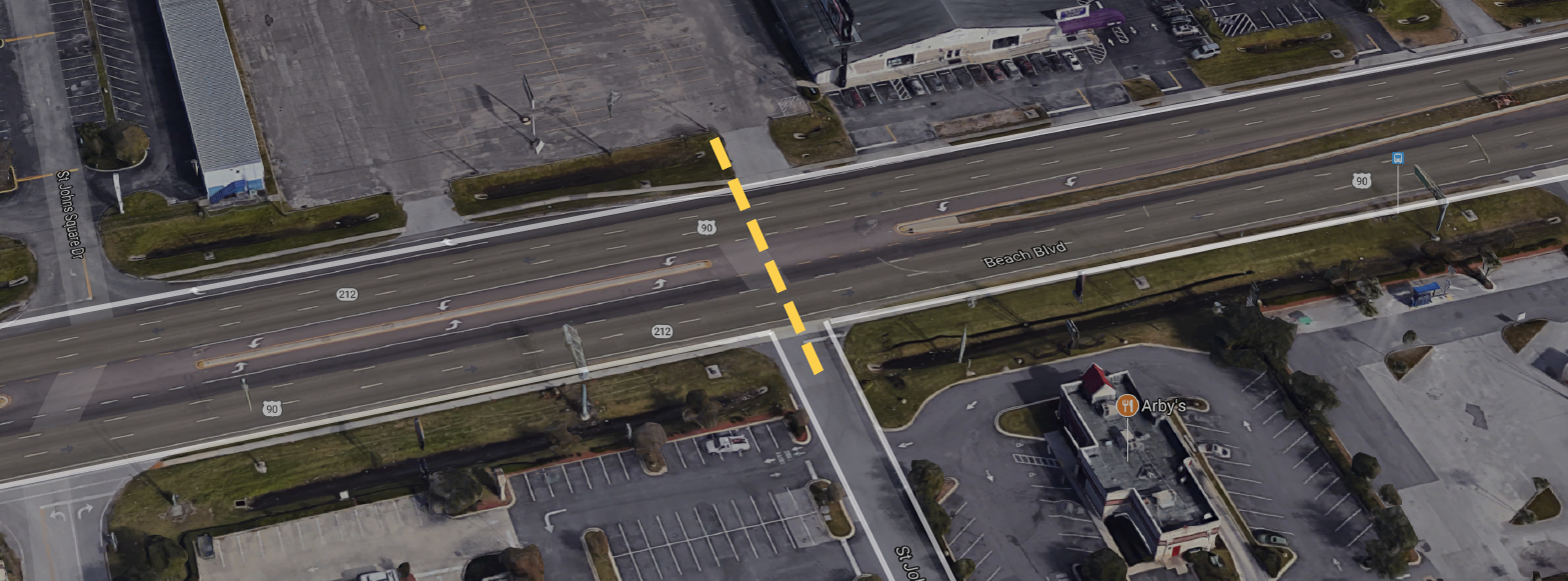How (Not) to Cross the Street in Jacksonville
Jacksonville, Florida, issues more tickets to pedestrians than all but five Florida counties. And it issues those tickets disproportionately to black pedestrians.
The city’s population is 29 percent black, but black pedestrians received 55 percent of the pedestrian tickets issued from 2012 to July 2017. Looking at each type of ticket issued reveals even bigger disparities.
Jacksonville’s 16 Most Commonly Issued Tickets From 2012 to 2017, by Race of Recipient

Jacksonville residents
29% black
71% nonblack
Violation
Tickets
Tickets issued
In roadway (sidewalks provided)
386
78% black
22% nonblack
Crossed intersection diagonally
17
71
29
Didn't cross road with shortest route
64
70
30
In roadway or left shoulder (no sidewalks)
101
69
31
Crossed roadway facing red light
24
63
37
Entered roadway against red light
20
60
40
Didn't obey traffic control device
265
53
47
Didn't cross in crosswalk
657
52
48
Obstructed flow of traffic
129
50
50
Didn't cross in crosswalk with green turn arrow
26
46
54
Didn't yield to traffic
198
46
54
Walked into path of vehicle suddenly
96
42
58
On limited access facility or connecting ramp
127
38
62
Didn't obey railroad traffic control device
9
33
67
Didn't yield (tunnel/overhead walk provided)
19
32
68
Solicited while on roadway or pavement
57
26
74

29% of Jacksonville’s
residents are black
Walked in roadway (sidewalks provided)
78% black
Crossed intersection diagonally
71
Didn't cross road with shortest route
70
In roadway or left shoulder (no sidewalks)
69
Crossed roadway facing red light
63
Entered roadway against red light
60
Didn't obey traffic control device
53
Didn't cross in crosswalk
52
Obstructed flow of traffic
50
Didn't cross in crosswalk with green turn arrow
46
Didn't yield to traffic
46
Walked into path of vehicle suddenly
42
On limited access facility or connecting ramp
38
Didn't obey railroad traffic control device
33
Didn't yield (tunnel/overhead walk provided)
32
Solicited while on roadway or pavement
26

29% of Jacksonville’s
residents are black
Walked in roadway (sidewalks provided)
78% black
Crossed intersection diagonally
71
Didn't cross road with shortest route
70
In roadway or left shoulder (no sidewalks)
69
Crossed roadway facing red light
63
Entered roadway against red light
60
Didn't obey traffic control device
53
Didn't cross in crosswalk
52
Obstructed flow of traffic
50
Didn't cross in crosswalk with green arrow
46
Didn't yield to traffic
46
Walked into path of vehicle suddenly
42
On limited access facility/connecting ramp
38
Didn't obey railroad traffic control device
33
Didn't yield (tunnel/overhead walk provided)
32
Solicited while on roadway or pavement
26
Note: Tickets that were given out fewer than five times in five years are not shown. 2017 tickets include January through June.
Can You Cross the Street Legally in Jacksonville?
There’s a lot of confusion about what counts as crossing the street legally in Jacksonville, even among police officers.
Since 2012, law enforcement in Jacksonville have issued 658 tickets to people crossing the street while not in a crosswalk. According to an investigation by ProPublica and the Florida Times-Union, more than half of those tickets were issued in error.
Take this busy stretch of Beach Boulevard, in Jacksonville.

Is it legal to cross Beach Boulevard in the middle of a block, like at A or B?
It’s only legal at A
It’s only legal at B
A and B are both legal places to cross
Neither A nor B is a legal place to cross
According to statute 316.103(11), it’s illegal to cross between intersections that have traffic lights. The intersections on either side of A don’t have traffic lights, so it’s legal to cross as long as the pedestrian yields to traffic. We found that many tickets were issued to pedestrians who crossed the street at a place like example A, when it was actually legal to do so. We also found that a disproportionate number of these types of tickets were issued to black pedestrians.

Let’s look at the T-shaped intersection, where no crosswalk is marked. Can you legally cross here?
Yes, this is a legal crosswalk and cars have to yield to pedestrians.
It’s legal to cross here, but pedestrians have to yield to traffic.
No, it’s illegal to cross.
According to Florida law, “unmarked crosswalks” exist wherever roads intersect, including at T-shaped intersections, which means that pedestrians can cross legally. We also found tickets issued to pedestrians who crossed at T-intersections, when it was legal to do so.
Jacksonville Sheriff Mike Williams denied his agency targeted its ticketing at pedestrians in black neighborhoods and said that ticketing is aimed at locations with greater numbers of deaths or serious accidents.
But after taking pedestrian deaths into account, the Times-Union/ProPublica found no real connection between where pedestrians were killed and where tickets were being issued.
But All These Tickets Are Saving Lives, Right?
Since 2012, at least 194 pedestrians have been killed by drivers in Jacksonville. It is one of America’s five most dangerous metro areas for pedestrians. Even as tickets are issued to black pedestrians at a far higher rate than nonblack residents, the proportion of pedestrians fatally injured in traffic accidents who are black — 30 percent — matches almost exactly the proportion of Jacksonville’s population that is black.
What’s more, we found no discernible connection between where pedestrian deaths occurred and where law enforcement issues tickets.
We also found that although census tracts where the population was mostly black had a similar number of fatalities to other neighborhoods, those residents were ticketed anywhere from two to five times as much.
Fatal Crashes Are Evenly Distributed, But Tickets Aren’t
Each group of census tracts below represents about 20 percent of Jacksonville's population.
Note: 2017 crashes and tickets include January through June.
There’s also evidence that tickets do little to save lives. In 2015, Jacksonville hired consultants to make its streets safer. They recommended that the city slow down traffic and build sidewalks, marked crosswalks and other pedestrian-friendly infrastructure.
“Trying to educate people to cross the road safely when there aren’t crosswalks or where there’s missing sidewalks — it just doesn’t work,” said Andy Clarke, lead author of the recommendations.
Source: Florida Department of Highway Safety and Motor Vehicles, Florida Court Clerks and Comptrollers, American Community Survey, Google Maps